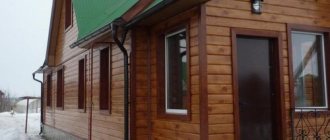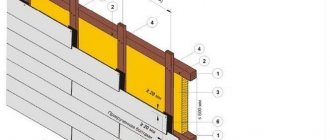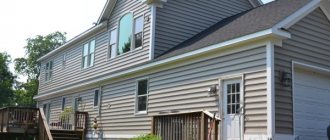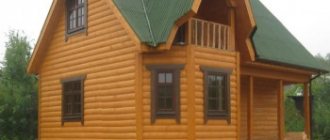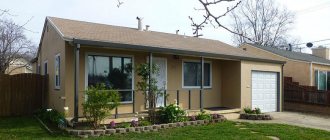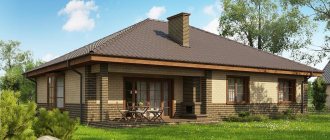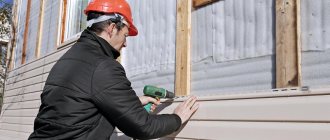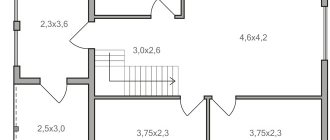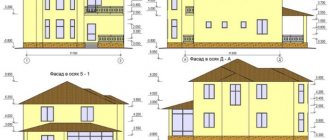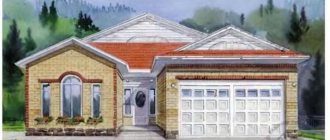Siding can imitate dark or light wood and come in neutral or watercolor tones. But how to choose a shade in such a variety? How to understand what combination of siding colors will look harmonious on your home? We will tell you what combinations of shades are possible for the facade. Let's look at the rules for choosing suitable colors. Let's see which colors are in the top for the exterior and which ones correspond to current trends.
Finishing with siding is practical and durable. Branded materials do not fade in the sun and retain color for a long time.
How to choose your own shade
The interesting color of siding in modern collections is the result of the work of designers. Often, complementary or contrasting shades are already presented in the series, and you can also see how a different material will look on the facade. Keep in mind that houses with dark or light windows look different, and this also needs to be taken into account.
Siding decoration refers to ventilated facade systems. It is used for frame, brick, aerated concrete, wooden, monolithic buildings (including as a restoration material). And the combination of colors allows you to give the cottage a new look.
Special programs for color selection
If you plan to decorate your house with siding, but you are not ready to do the design project yourself, you can use special computer programs. Typically these are tools for architects and designers, but their “basic” functionality may be available for free.
If you need to calculate the material for finishing the facade of a house when you have already selected the desired color, use the Grand Line calculator. It allows you to calculate the amount of vinyl siding or facade panels in accordance with the wall area. The shade, texture, width of the planks can be selected from the photos offered in the catalog. After the calculation, you will have an accurate estimate, which already takes into account all additional elements and fasteners. And you can immediately transfer the order to the manager for packaging.
Varieties of coloring
It is important to think without haste about what kind of decorative effect you want to achieve.
As for design recommendations, here they can be as follows:
- Regardless of the color, the house will look taller if the siding is fastened vertically, and wider if it is fastened horizontally;
- One- and two-story cottages of simple design can be interestingly played up by using contrasting combinations: for example, the walls can be dark wood, and the trim, cornices and drainpipes can be white, or the facade can be cream, and everything is extra. elements - saturated;
- the use of contrasting additions allows you to create bright accents, even if restrained and calm pastel colors are chosen as the background;
- but it is undesirable to use contrast for houses with a large number of protruding architectural elements: protrusions, on the contrary, are better made light in order to visually soften their massiveness;
- if you don’t like complex transitions and combinations, you can always choose a neutral pastel option (for example, ivory, golden sand, peach, caramel, vanilla).
Light or dark?
You can choose the option that you like best. Modern technologies make it possible to obtain siding with a decorative polymer coating that can be used all year round without loss of color. The latest technologies for creating decorative and protective coatings already take into account the fact that the facade of the house will be under constant influence of ultraviolet radiation. Keep in mind that dark panels will attract more sunlight, so the house may be warmer than usual. And on pastel shades, fading is almost unnoticeable.
Also, when selecting, you can focus on generally accepted stylistics. For example, if you like classics, then you can choose a trim shade from a beige and cream palette. Fading on such shades is unnoticeable for many years. Dark shades of graphite, rowan, black coal or “chocolate” wood give the building extravagance.
If you want to turn your home into a “wooden” one, choose textured finishes in the colors of hornbeam, ash, dark or light oak, maple, cedar, birch and so on. And if it is important to highlight the cottage against the background of the existing landscape, to attract attention to it, then they give preference to bright and appetizing tones. This category offers a wide range of colors, including light green, peach, blue, dark beige, and gray.
Also, the choice of a suitable tone for the walls and roof can be made based on the “mood” of the shade and its compatibility. The recommendations here are as follows:
- Gray looks noble and discreet, looks good in imitation stone and wood. It belongs to neutral tones, which means it can easily be combined with any roof. Of the entire palette, gray-blue looks the most aristocratic.
- Beige is a color from the warm palette that also suits the classic style. It gives the building visual lightness and provides a feeling of home comfort. At the same time, such a cottage may well look like an aristocratic residence. It can be combined with other shades of facade panels. As for the combination with the roof, the following companion shades are possible: dark green, blue, brown.
- The green color of the facade is suitable for buildings with a dark or light roof. Such a house will look especially impressive if there are many trees around the house or if there are well-groomed areas with an emerald lawn.
- Brown siding in different shades will perfectly imitate wood. Therefore, it is perfect for eco-style buildings. The cladding can imitate solid wood or masonry. To ensure a complete imitation of natural cladding, you can select the appropriate siding configuration. This can be a shipboard, standard or Slim, as well as a block house or Natural timber. Such ventilated structures will look rich and interesting. In addition, the walls of a building in dark colors will warm up better.
- Blue or cyan tone looks most impressive in combination with white. The result is a feeling of lightness and relaxation. Such buildings can be associated with the Mediterranean style.
- The red color of the cladding looks impressive and immediately catches the eye. This can be either a classic or an extravagant solution. The classics include imitation clinker masonry, terracotta brick or mahogany-like cladding. Extravagant solutions include stripes of rich color. You can also choose red roofing materials, and such a house will definitely be different from its neighbors.
But that's not all. Let's figure out what shade to choose for the panels.
What is the difference between the vertical version and the horizontal one?
Many people mistakenly believe that the differences between the varieties are only in the technology for installing the frame posts. But products for facade cladding, located vertically, are an independent type of finishing material. The main feature of such products (when compared with horizontal ones) is the absence of perforation on the lower part of the locking joint, so the drainage of moisture and condensation from vertical panels is much easier. But the upper part opens, which requires the use of special overhead profiles.
Vertical and horizontal models are structurally different
The process of fixing parts is also significantly different. Although the general principle is similar, vertical panels require a more clearly thought out layout. In addition, they can be attached in two ways: from the corner and from the center. And in the absence of work experience, it will take much more time and effort.
Using this option for cladding allows you to change the visual configuration of the house, giving it a more elongated appearance. This is also a good way to delimit a multi-story building (see photo).
Mixed installation method gives excellent results
On a note! A good option is a combination of vertical and horizontal varieties, provided that the joining profiles are chosen correctly.
How to combine colors with each other?
Of course, the easiest way is to use the material in one tone. In this case, there is no need to select color options for the roof and walls at all, but it may turn out that the appearance of the building will be too “boring and predictable.” If you do not want to make a multi-colored facade, but at the same time you want the house to look interesting, you can choose different materials for the basement cladding and for the walls. In the photo, such houses look much more interesting!
Let's figure out how to make a really good choice, given the variety of siding options and the availability of many colors.
Ways to combine colors
The cladding of the facade of the house includes several structural elements, each of which can be painted in a different color. These are the walls themselves, the basement, as well as the roof and corners, window and door slopes, drainpipes and soffits on eaves.
You can combine them with each other as follows:
- the base and roof can be made of the same shade, and for the walls you can choose a different option;
- corner elements can be chosen white or dark brown to create contrast;
- Soffits, gutters and slopes can also be contrasting or match the tone of the basement cladding.
If you want to demonstrate restraint and visually enlarge the building, then use light shades. You don’t have to give up contrasts: for example, a beige background can be combined with white decorative elements. Pastel siding colors look good against a dark fence or in a dense garden with tall trees. But if you need to hide a house in such a landscape or visually reduce the structure, then they give preference to dark tones.
A house lined with bright siding will look more fresh and interesting. But exterior designers do not recommend using more than one such tone in decoration. This solution can be chosen for houses with complex architectural elements. So, the decor can be made lighter than the facade, and the entire building will benefit from this, as it will acquire elegance.
A classic combination is considered to be a combination that came from the wardrobe. This is “dark bottom, light top,” that is, a base lined with stone, brick or wood in rich colors, and walls that are made light. The color of the base here can be duplicated in the roof, slopes and corner elements.
If you arrange the colors in reverse (light ones at the bottom and dark ones at the top), then we will be talking about a design technique called “inversion.” Looks bold and modern. With the right selection of shades, such a house will look “hanging in the air.” Another interesting design solution was invented for cottages with more than one floor. They can combine tones of a cold or warm palette. For example, one floor can be made beige and the second terracotta, or one floor can be gray and the second blue.
In addition, you can make colored inserts along the facade, and this solution can be implemented regardless of the number of floors of the building. For example, the window area is sheathed in brown, and beige is used throughout the facade. Or they combine two shades of blue, green, brown. Inserts can be arranged in stripes: vertical ones will create an additional effect of height, and horizontal ones will make the building visually wider and more stable.
But what colors can be combined with each other? Professional designers usually use a color wheel to answer this question.
Combination of siding colors on a house: using a chart
The Itten color circle or color chart is considered standard, which is used by all design specialists without exception (from stylists to DIY craftsmen). It is a circle divided into segments with different shades.
You can combine colors using it in the following ways:
- in a straight line, that is, by choosing two tones from opposite sides: here we are talking about complementary, contrasting colors, the combination of which is perceived as very harmonious;
- neighboring, that is, adjacent colors, of which there can be two or three: as a result, you will get a facade that will have a calm feel, and a combination of calm pastel colors will look especially impressive and win-win here;
- triangle combination: first choose one suitable color, and then build an isosceles triangle on a circle from this vertex, and this way you will get a lively and bright combination even based on pastel or watercolor shades;
- a combination of 4 shades, in a square: as in the previous case, a geometric figure is built, and this combination turns out to be the most vibrant and multi-colored.
Description
The material consists of panels, which subsequently acquire an integral system on the facade of the house. The material used to produce products is varied . Accordingly, each type of siding has its own characteristics and performance characteristics.
There are quite a lot of options for implementing the desired design solution; each type of product has its own color scheme and variety of textures. Basically, the products are characterized by a fairly high level of strength and reliability; they are also profitable to use because their price level is not too high.
Beautiful siding for cladding a house - photo:
Top 10 siding color combinations
Bright and unusual or traditional combination of siding colors on the house - which is closer to you? Here are the TOP colors that will definitely go together! Each color combination here is 100% thought out and looks great next to popular landscapes.
Successful color combinations on the facade
Choose one of the ten proposed combinations. Don't forget that these are the most common solutions and you may not be limited to them. In fact, there can be many more combinations. For example, you can always add a third color to the proposed combinations.
So let's get started. Here is the same TOP 10:
1. White is considered a universal color. It can even be used for a small cottage if you want it to look visually larger. White can be combined with any base, with a dark or light roof. And if you highlight the corners with a dark shade, the house will look like an Austrian one, built using the half-timbered technology. Also, this color practically does not fade in the sun, and maintaining its cleanliness is not difficult (due to the smooth surface). So this option can be called a win-win. And, indeed, it is the leader in popularity. 2. Beige is a warm color and is associated with natural materials. Such a house looks natural, environmentally friendly and cozy. It is also important that you can choose almost any companion color for the beige facade. For example, blue and green are suitable, as well as brown, peach, sand and blue. 3. Yellow color is perceived as positive, sunny, life-affirming. It can be used in combination with floral or “appetizing” shades - such as orange, lilac, light green. 4. Brown color will visually make the house more compact and tidy. It can be used in imitation wood paneling. As for companion shades, choose light green and green tones, as well as peach, beige or white. 5. Green tone will look good against the backdrop of a garden, forest or open sky. It combines beautifully with other shades of greenery or foliage, as well as beige or brown. 6. Cream tones are discreet and stylish; they look aristocratic and warm. They go well with other soft tones, including beige, caramel, and sand. They also look great with wood tones. 7. Blue is associated with the sky, sea, vacation. Such a house can look elegant and festive. The blue facade itself is quite bright, so it is good to balance it with dark colors like cherry, dark blue or brown. If you want to choose a light companion, give preference to light green or beige. 8. Pink is suitable for small beautiful country houses surrounded by flower beds and rose gardens. It can be combined with green, blue, chocolate. The result will be a beautiful Provence aesthetic. 9. The burgundy facade looks more solemn and richer than brown. It can be combined with light green, gray, white or beige. 10. Gray may look cold, but is still elegant. It can be complemented with the same shades, differing by a couple of tones, as well as with sand or cherry.
Combination of siding color with roof color
Let's now figure out what the correct combination of siding and roof colors should be. You don't have to make contrasting inserts on the walls. After all, you can simply experiment with roof finishing!
The color of the siding can match the roofing material and the shade of the gutter system tone-on-tone. But on the facade of a private house the contrast always looks more interesting.
- the white color of the facade can be complemented with absolutely any roof;
- a light green house will look beautiful if its roof is red, dark gray, brown wood or rich chocolate;
- beige cladding is harmoniously complemented by any dark tones, including brown;
- for yellow you can choose blue, green or even orange, or you can limit yourself to dark gray;
- brown goes well with the same color (the difference may be 1-2 tones);
- with a blue facade you can combine a dark blue or chocolate roof, as well as rowan or cherry colored material;
- a roof of red, brown, or coffee colors will suit a green house;
- The gray facade is combined with a green, blue, dark gray roof, and you can also choose cherry.
If you use two different colors for the facade, contrasting or close to each other, then you need to make sure that both of them will be combined with the roof.
Ceramic siding
Ceramic siding (ceramosiding) is the youngest type of siding, developed by Japanese specialists.
The composition of the ceramics used to produce this finishing material includes fiber cement mixture and clay, and other components of natural origin are also added. Therefore, ceramic siding is one of the fireproof, hypoallergenic, environmentally friendly finishing materials. In addition, it is superior to other types of its “brother” in noise absorption and breathability.
The quality of the surface lined with ceramic siding is comparable to ceramic tiles.
Types of siding for finishing a house, what kind of siding there is (+ video)
Siding is made from different materials. This could be vinyl, metal (thin sheet galvanized steel), fiber cement board, and so on. Each variety has its own rich palette. In addition, the facing material can be produced smooth or textured. In the latter case, we are most often talking about imitation wood, stone or brick.
Vinyl siding
This material is made on the basis of polyvinyl chloride, PVC. It is lightweight, highly flexible, and is available in various aesthetic collections. Such products are completely environmentally friendly and can be used perfectly in the temperature range from -50 to +50 degrees. Separately, it is worth noting the chemical resistance and fire safety of the material. The service life of such cladding is more than 50 years. It can be mounted on a metal or wooden frame. Branded additional elements and fasteners are produced, which can be immediately purchased as a set.
Metal siding
This material is strong, durable, and can have a smooth or textured surface. A two-layer protective and decorative coating is created on the surface: the steel sheet is first galvanized and then coated with polymer, resistant to external influences and UV radiation. Among the advantages of metal material is increased wind and impact resistance. It also perfectly resists moisture and is practically not subject to corrosion. This type of material can be used for the base, for loaded areas that are in direct contact with the ground and rainwater.
It is not forbidden to use metal siding for the base, and cover the facade itself with vinyl material. The fact is that PVC products have more color and design solutions. In addition, they are lighter and do not create additional load on the foundation.
Siding from other materials
This segment includes fiber cement and wood siding. The first option is made on the basis of cement reinforced with fiber fiber (this additive protects the material from cracking). This material is durable, environmentally friendly, and has a long service life.
The second option can be made from natural wood, timber, or a combination of wood sawdust and composite binders. WPC is considered a more durable solution. But natural wood is too demanding and requires constant maintenance. So, you will need to protect the wooden cladding from pests, from moisture, and from fire. It is recommended to renew the protective coating at least once every two years.
Horizontal and vertical siding
Previously, siding was attached exclusively horizontally, but modern materials can be installed in any position. It is believed that the arrangement of stripes vertically visually increases the height of the building, and horizontally - expands the structure. You can also use a combined fastening method (for example, when siding is fastened horizontally on all walls, and openings and corners are framed with vertical elements).
By the way, it is considered that siding is fixed vertically. tolerates temperature changes more easily. In addition, in this case, the flow of water into the installation seams after rain is almost completely eliminated.
Once covered with siding, the finished frame house will be radically transformed. The sheathing process can be seen in our video. Here all the nuances of the work are discussed, the installation of the entire suspended ventilated structure, starting from the insulation, is shown. You will also see exactly what structural and additional elements will be needed for installation. In addition, the specialist analyzes the nuances of combination, shows which contrasting shades can be used for different areas of the facade and why.
Installation technology
Siding is installed on a sheathing (or subsystem) - a supporting structure that performs several functions in parallel :
- Supporting structure for panels.
- Leveling uneven walls.
- Support for insulation material.
Normal installation is done from the bottom up. A starting strip is installed, which is a separately made locking part of the panel. Corner or connecting H-profiles are immediately installed, window openings and a pediment are designed.
Then the installation of the panels begins. The lower part snaps into the lock of the starting bar or the previous panel, the upper part is fixed with self-tapping screws .
PLEASE NOTE! Tight fastening of panels to the sheathing is prohibited. The screw heads should be at a distance of 1.5-2 mm from the surface so that the panels can move sideways during thermal expansion of the material.
The installation of the finishing strip completes the installation..
Characteristics of color fastness of siding
Siding is used as cladding in ventilated facade systems. It allows you to protect the house from cold or overheating, as well as from excess humidity, since condensation does not accumulate in it, and the area under the cladding is well ventilated.
Thanks to such panels, you can quickly give your home a modern and aesthetic look, even if we are talking about old and unpresentable buildings made of brick or timber.
But it is important that the new cladding remains attractive for as long as possible. This is why the color fastness characteristics of siding are so important. The material uses a polyester protective and decorative coating with increased durability and UV resistance. It can be used without changing color even on the sunny side for 10 years. After this period, the material may fade or turn slightly yellow, but this does not mean that it cannot be used further.
You should also remember that dark colors are more susceptible to fading. The material will suffer more from ultraviolet radiation if the wall of the house faces south. If the house is in the shade, fading will be less noticeable. “Yellowing” practically does not appear on beige or caramel shades. It is important to know that the change in tone occurs smoothly, gradually, that is, you will not encounter the fact that the house will lose its attractiveness after the summer.
The Grand Line company provides a long-term guarantee for color stability and immutability for its collections:
- 5 years on vinyl siding, soffits and additional brown elements;
- 11 years on vinyl siding from the Classic collection;
- 13 years for premium colors of vinyl siding from the Classic collection;
- 15 years on the colors (ACA) of the premium collection of Acrylic vinyl siding and the Tundra design collection of vinyl siding.
The material itself is designed for a 50-year service life.
Features of care
To maintain the neat appearance of your home, it is necessary to occasionally clean the surface of the siding panels from dirt. If the contamination is insignificant, then it can be easily removed using a strong stream of water . You can use a regular Karcher for this. If more significant dirt appears on the surface, use a soft brush to remove it.
If mold is found on some panels, then after removing it, the panels must be treated with a solution with a 5% concentration of chlorine. It is prohibited to use chlorine in its pure form on panels. You cannot clean the surface if the temperature outside is low.
It is not recommended to use various cleaning products that include abrasive structures, as they can damage the top layer of the material . Chemicals should not be left on the siding surface for more than 10 minutes.
What should not be used in the exterior
To create a truly attractive home exterior, you need to be aware of common mistakes that non-experts make. Here are the main ones:
- using more than three shades;
- purchasing materials of different colors without evaluating real samples, only based on photos;
- purchasing in small quantities, when you may come across shades from different batches with differences in tone;
- choosing a color without taking into account the location of the building in the cardinal directions: for example, if you buy a dark tone for a house with walls facing south, standing in an open area, the material will quickly fade;
- the color is chosen without taking into account the mood that it evokes in you (if red seems too aggressive to you, and gray makes you sad, you should not use them for your home, even if “stylists recommend”).
Now you know about all the main recommendations.
Advantages and disadvantages
Sheathing a house with vertical siding has the following advantages:
- Opportunity to express individuality. With the right choice of color and texture, the coating turns out original and stands out from the general background.
- Visual expansion of a small house. The structure looks more voluminous and elongated. This solution is suitable for almost all styles.
- If you understand the installation technology, the process will not take much time.
- A vertical composition will be an excellent option for distinguishing multi-storey buildings and cottages.
Vertical installation makes the building visually taller
Flaws:
- In the absence of skills and experience, difficulties may arise, especially in the correct installation of additional profiles.
- Installation of the J-bar for lower fixation in the absence of perforations will require drilling the holes yourself. It is also necessary to periodically clean it of accumulated debris and dirt.
- The mandatory installation of a metal drain is required to ensure high-quality drainage.
The size of the material depends on the specific manufacturer, but the most common length is about 3 m with a width of 190 mm.
Vertical siding models differ in size from traditional planks
